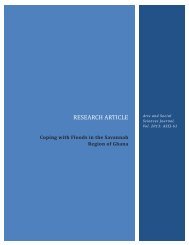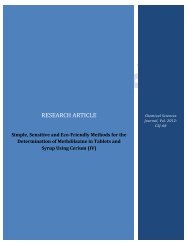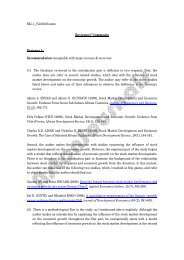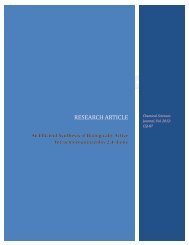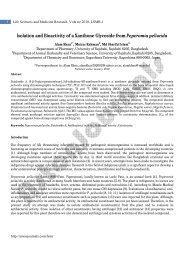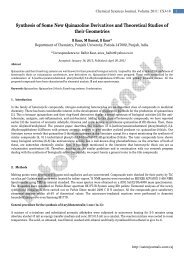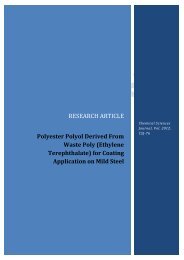Rapid and Sensitive Spectrophotometric ... - AstonJournals
Rapid and Sensitive Spectrophotometric ... - AstonJournals
Rapid and Sensitive Spectrophotometric ... - AstonJournals
You also want an ePaper? Increase the reach of your titles
YUMPU automatically turns print PDFs into web optimized ePapers that Google loves.
10 Research Article<br />
3.2 Method validation<br />
3.2.1 Analytical parameters<br />
A linear relation was found to exist between absorbance <strong>and</strong> the concentration of PPL in the ranges given in Table<br />
2. The calibration graph in each case is described by the equation:<br />
Y = a + b X<br />
where Y = absorbance, a = intercept, b = slope <strong>and</strong> X = concentration in µg ml -1 , obtained by the method of least<br />
squares. Correlation coefficient, intercept <strong>and</strong> slope for the calibration data are summarized in Table 2. Sensitivity<br />
parameters such as apparent molar absorptivity <strong>and</strong> S<strong>and</strong>ell’s sensitivity values, the limits of detection <strong>and</strong><br />
quantification calculated as per the current ICH guidelines [41] are compiled in Table 2 <strong>and</strong> are indicative of the<br />
sensitivity of the methods. The limits of detection (LOD) <strong>and</strong> quantification (LOQ) were calculated according to the<br />
same guidelines using the formulae:<br />
LOD=3.3σ/s <strong>and</strong> LOQ=10σ/s<br />
where σ is the st<strong>and</strong>ard deviation of five reagent blank determinations <strong>and</strong> s is the slope of the calibration curve.<br />
Table 2: Regression <strong>and</strong> analytical parameters.<br />
Parameter BTB Method BCG Method BCP Method<br />
max , nm 420 425 420<br />
Beer’s law limits (µg ml -1 ) 0.4-7.0 0.4-7.0 0.6-8.4<br />
Molar absorptivity (l mol -1 cm -1 ) 3.55×10 4 3.12×10 4 2.94×10 4<br />
S<strong>and</strong>ell sensitivity * (µg cm -2 ) 0.0073 0.0083 0.0088<br />
Limit of detection (µg ml -1 ) 0.03 0.04 0.06<br />
Limit of quantification (µg ml -1 ) 0.10 0.12 0.18<br />
Regression equation, Y ** ; Intercept (a) -0.0160 -0.0089 0.0017<br />
Slope (B) 0.1420 0.1276 0.1123<br />
Correlation coefficient (r) 0.9982 0.9999 0.9991<br />
St<strong>and</strong>ard deviation of intercept (S a ) 0.01819 0.00346 0.01239<br />
St<strong>and</strong>ard deviation of slope (S b ) 0.00432 0.00082 0.00246<br />
* Limit of determination as the weight in µg per ml of solution, which corresponds to an absorbance of A = 0.001 measured in a<br />
cuvette of cross-sectional area 1 cm 2 <strong>and</strong> l = 1 cm. **<br />
Y a bX<br />
, where Y is the absorbance, a is the intercept, b is the slope <strong>and</strong><br />
X is the concentration in µg ml -1 .<br />
3.2.2 Precision <strong>and</strong> accuracy<br />
The precision of the methods was calculated in terms of intermediate precision (intra-day <strong>and</strong> inter-day). Three<br />
different concentrations of PPL were analyzed in seven replicates during the same day (intra-day precision) <strong>and</strong><br />
five consecutive days (inter-day precision). The RSD (%) values of intra-day <strong>and</strong> inter-day studies showed that the<br />
precision was good (Table 3). The accuracy of an analytical method expresses the closeness between the reference<br />
value <strong>and</strong> the found value. Accuracy was evaluated as percentage relative error between the measured<br />
concentrations <strong>and</strong> taken concentrations for PPL (Bias %). The results obtained are compiled in Table <strong>and</strong> show<br />
that the accuracy was good.<br />
3.2.3 Robustness <strong>and</strong> ruggedness<br />
The robustness of the all the methods was evaluated by making small incremental changes in the volume of dye (1<br />
± 0.2 ml) <strong>and</strong> contact time (5 ± 1 min) in method C, <strong>and</strong> the effect of the changes were studied on the absorbance<br />
of the ion-pair complex. The changes had negligible influence on the results as revealed by small intermediate<br />
precision values expressed as % RSD (≤ 1.43 %). Method ruggedness was demonstrated having the analysis done<br />
by four analysts, <strong>and</strong> also by a single analyst performing analysis using four different cuvettes. Intermediate<br />
precision values (%RSD) in both instances were in the range 0.99 - 1.74 indicating acceptable ruggedness. These<br />
results are presented in Table 4.<br />
http://astonjournals.com/csj



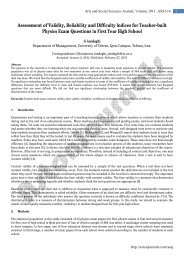
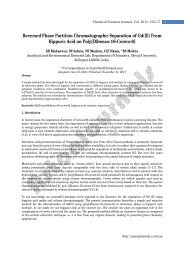
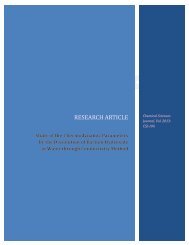
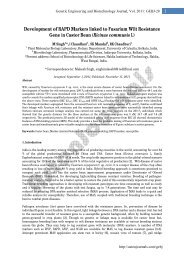
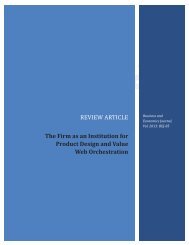
![[1,4]-benzodiazepine-2-one Derivatives as Potent - AstonJournals](https://img.yumpu.com/49117784/1/184x260/14-benzodiazepine-2-one-derivatives-as-potent-astonjournals.jpg?quality=85)
